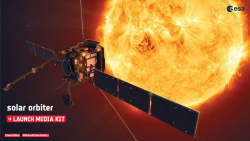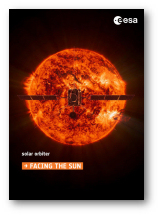ESA Science & Technology - Publication Archive
Publication archive
Publication archive
Download this interactive media kit to learn more about the launch of Solar Orbiter in February 2020 and the science goals of the mission. Solar Orbiter will perform unprecedented close-up observations of the Sun and from high-latitudes, providing the first images of the uncharted polar regions of the Sun, and investigating the Sun-Earth connection.
Contents:
- Introduction
- How to use this media kit
- Event programme
- How to follow the launch online
- What’s new
- Answering the big questions
- Operating in extreme environments
- Instruments
- Launch and deployment sequence
- Journey around the Sun
- Extreme exploration with Solar Orbiter and Parker Solar Probe
- Anatomy of the Sun
- Missions studying the Sun
- Meet the Sun
- Solar Orbiter team
- Selected multimedia
- Media services
To open the pdf file (16 MB) click on the image or on the link to publication below.
Solar Orbiter is a mission dedicated to solar and heliospheric physics. It will address big questions in Solar System science to help us understand how the Sun creates and controls the heliosphere, the giant bubble of plasma that surrounds the whole Solar System and influences Earth and the other planets within it. The spacecraft will provide close-up, high-latitude observations of the Sun to gain new information about the solar wind, the heliospheric magnetic field, solar energetic particles, transient interplanetary disturbances and the Sun's magnetic field.
Contents:
- Living with a star
- Exploring our Sun
- Anatomy of our Sun
- Preparing for extreme environments
- How Solar Orbiter will study the Sun
- Launching and operating Solar Orbiter
- Teamwork with Parker Solar Probe
- An international enterprise
This report, the so-called Red Book, presents an overview of the Solar Orbiter mission in its present state of advanced definition. Solar Orbiter is a medium-size (M-class) mission of the ESA Cosmic Vision 2015-2025 programme, and competes for one of the two launch slots foreseen in 2017 and 2018.
This technical review report for the Solar Orbiter candidate mission presents the outcome of ESA's internal review of this M-class candidate mission in the Cosmic Vision 2015-2025 plan. The review was concluded at the end of the mission assessment phase and carried out in frame of the down-selection to 3 or 4 M-class missions, which will proceed to the definition phase. The main goal of this internal review was to identify the mission's critical issues and associated risks at technical, programmatic and financial level.
Note: This report has been superseded by the Solar Orbiter definition study report (Red Book), released in July 2011, which is linked from the right-hand menu.

